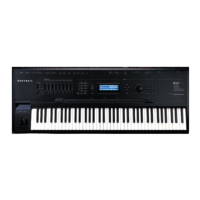7-10
Setup Mode
The Key/Velocity (KEY/VEL) Page
Low Key (LoKey), High Key (HiKey)
The LoKey and HiKey parameters define the note range of the currently selected zone. The
easiest way to change these values is to press the Enter button and press the key of the note you
wish to enter. You can set these values with normal data entry methods as well.
You can create “negative” ranges as well. To do this, select the HiKey parameter and set its limit
lower than the LoKey limit. This results in the zone being active at the top and bottom of the
keyboard, but being silent in the range between the two limits. This lets you create a layer with a
“hole” in the middle, which you can then fill with a different sound on another zone.
The limits of MIDI are C-1 to G9. The untransposed 88-key range is A0 to C8. The untransposed
76-key range is E1 to G7.
Transpose
This changes the pitch of the zone, without changing its position on the keyboard. It changes the
MIDI note numbers generated by the keys in the zone, without physically shifting the zone. The
range is -128 to 127 semitones. Since there are 12 semitones (or half steps) to an octave, you can
transpose up or down over ten octaves. If you transpose out of the range of the active voice,
however, no notes will sound; MIDI note numbers will transmit, but notes will not.
Note Map
Note Map lets you change the way notes are sent from the PC3. The default setting is Linear: all
notes go out as played. Pressing the Minus button takes you to Off; no notes are sent, but
controllers and other non-note data are.
Setting Note Map to Inverse effectively turns the keyboard upside-down, with the highest key
being A 0 and the lowest C 9. If you set Note Map to Constant, all of the keys on the keyboard
will play the same note. The note defaults to C4, but you can change this with the Transpose
parameter. This works well when you want the sound from a particular key to play with every
note of another zone—for example, playing a ride cymbal with every note in a bass line.
Next are the alternating note maps, which let you divide the keyboard in some unique ways. If
you are using two or more MIDI devices (including the PC3), you can expand polyphony by
assigning each zone to a different alternating note map. For example, if you have two PC3s, you
can assign two zones to each play the same program on a different PC3, thereby doubling
polyphony.
To split a zone into one of two alternating note maps, set Note Map to 1 of 2; now the zone plays
on every second key, starting on C, but won’t play on any other keys. Set another zone to 2 of 2,
and this zone will play on every second key, starting on C
#
, thus covering the remaining keys.
Three- and four-zone alternating notemaps work the same way, but cause each zone to play only
on every third and every fourth key, respectively.
Note maps are also used to create drum patterns with the arpeggiator. Several of the ROM
setups use this feature.

